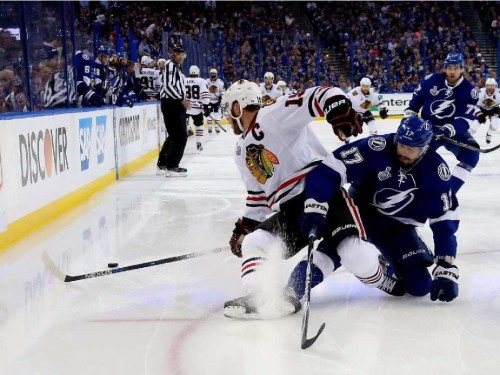No Fighting, No Problem in 2015 Stanley Cup Playoffs

It may seem like beating a dead horse at this point but these playoffs have added even more fuel to the fire that is the debate over fighting’s place in hockey.
Before getting into the debate, let’s start with a simple question: has anyone even noticed the lack of fighting, or knowingly missed it, to this point in the playoffs? Maybe the diehards who only watch the games to see fights – few as they may be – but to the average fan the intrigue likely hasn’t wavered. That’s because fighting and excitement don’t go hand-in-hand.
The purpose of this article isn’t to explain why hockey doesn’t need fighting – I’ve already taken on that subject. It’s simply an illustration of how much better the average NHL game (playoffs or otherwise) can be without players constantly throwing down.
First of all, let’s start with some numbers: through the entirety of these playoffs there have been a grand total of eight fights (by comparison, it took only four days to reach that total in the regular season). Five of those came between the Calgary Flames and Vancouver Canucks, and the last fight occurred in the second round between the New York Rangers and Washington Capitals.
And it would be more than a fair assessment to say that, with the exception of a few dud games, the overall quality of the series in which there were no fights didn’t suffer. There are perhaps a multitude of reasons for this, but the one that is most plausible is the fact playoff hockey is another animal in itself.
That the lack of fighting hasn’t had an adverse effect on the excitement or intensity of the games is no doubt a testament to the exceptional pace of play. The hits are just as hard, if not harder – and more plentiful (or so it seems) – players are just as willing to mix it up in the course of the game as they are after whistles and yet no punches are thrown.
If anyone needs proof of the total change in mantra that comes from post-season hockey, look no further than the net-front scrums after whistles. On numerous occasions players have shown restraint in opting not to drop the gloves, instead choosing to face wash or simply skate away in situations that would otherwise provoke a fight – proving, once again, the conscious effort being made to avoid fighting.
Of course, the role of the fighter can’t be overlooked in the equation: More often than not it’s a bottom six forward or a third pair defenceman who gets his hands dirty. Coincidentally enough, it is these very players whose ice time sees the biggest drop-off in the playoffs, especially in the critical moments of the game.
But such a trivial fact can’t account for what has been a monumental reduction in the number of fights (in relative terms). Sure it has some effect, but there’s something larger at play here. The task now becomes trying to replicate the style of play from the playoffs in the regular season, which, although difficult, is still doable.
The advocates of fighting often claim hockey couldn’t survive without fighting; that getting rid of it would alienate more fans than it would attract; that the league would quickly realize its mistake and backtrack just as fast.
But if the 2015 playoffs (or any playoffs, for that matter) are any indication, hockey will be just fine.
*Fight stats courtesy of hockeyfights.com

